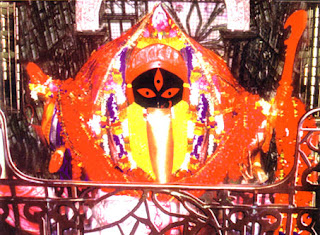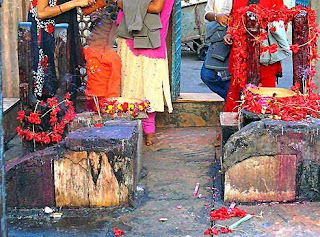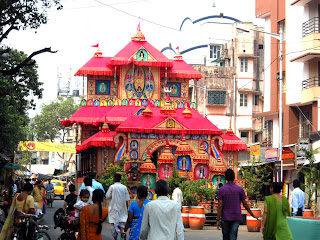+-+c1912-14.jpg) |
| 17th century Kalighat Temple Kolkata (Calcutta) |
17th century Kalighat Temple Kolkata (Calcutta), The Kalighat temple in
its present form is only about 200 years old, although it has been referred to
in Mansar Bhasan composed in the 15th century, and in Kavi Kankan Chandi of the
17th century. Only two types of coins of Chandragupta II, who incorporated
Vanga in the Gupta Empire, are known from Bengal. His Archer type coins, which
became the most popular type of coinage with the Gupta rulers after Kumaragupta
I, have been found in Kalighat. This is evidence of the antiquity of the place.
The original temple was a small hut. A small temple was constructed by
King Manasingha in the early 16th century. The present temple was erected under
the patronage of the Sabarna Roy Chowdhury family of Barisha. It was completed
in 1809. The Haldar family claims to be the original owners of the temple
property. But this was disputed by the Chowdhrys of Barisha. In the 1960s a
committee was formed for the administrative management of the temple with
representation from the Government and the Haldar family. The responsibility of
conducting the worship rests with the Haldars and their heirs, generally known
as shebaits.
Temple
Details
Shoshti Tala
This is a rectangular altar about three feet high bearing a small cactus
plant. Beneath the tree, on an altar three stones are placed side by side -
left to right representing the Goddesses "Sosthi",
"Sitola", and "Mongol Chandi". This sacred spot is known as
Sosthi Tala or Monosha Tala. This altar was constructed by Gobinda Das Mondal
in 1880. The place of the altar is the Samadhi of Brahmananda Giri. Here all
the priests are female. No daily worship or offering of Bhog (food offering) is
done here. The Goddesses here are considered as part of Maa Kali.[citation
needed]
Natmondir
A large rectangular covered platform called Natmondir has been erected
adjacent to the main temple, from where the face of the image can be seen. This
was originally built by Zamindar Kasinath Roy in 1835. It has been subsequently
renovated often.
Jor-bangla
The spacious varandah of the main temple Facing the image is known as Jor
Bangla. Rituals occurring inside the sanctum sanctorum are visible from the
Natmondir through the Jor-bangla.
Harkath Tala
This is the spot adjacent to the Natmondir, southwards meant for Bali
(sacrifice). There are two Sacrificial altars for animal sacrifices side by
side. These are known as Hari- Kath.
The bigger one is for buffalo sacrifices and the smaller one for goats
and sheep. The animals are sacrificed with a single stroke of the scimitar and
there is very little cruelty to animals when compared to the professional
abattoirs.
Radha-Krishna Temple
This temple is known as Shamo-ray temple and is situated inside the
temple at the west side of the main temple. In 1723, a settlement officer of
Mushirabad district first erected a separate temple for Radha-Krishna. In 1843
a Zamindar called Udoy Narayan Mondal erected the present temple in the same
spot. The Dolmancho was founded in 1858 by Madan Koley of Saha Nagar. There is
a separate kitchen for preparation of vegetarian Bhog (food offering) for
Radha-Krishna.
Kalighat Temple Tank
(Kundupukur)
This is the sacred tank situated in the south-east of the temple outside
the boundary walls. Present area of the tank is approximately 10 cottahs. In
the past it was bigger and called 'Kaku-Kunda'. In 16th century 'Sati-Ango' (
the right toe of Sati) was discovered from this tank. This tank is well known
for its power to bestow the boon of a child. The water from this tank is
regarded as sacred as that of the Ganges. Efforts at draining the water from
the tank for cleaning has failed in the past showing the possibility of a
subterranean with Adi Ganga.
Associated
Temples
Nakhuleshwar Mahadev
Temple
This Siva temple is dedicated to the consort of Maa Kali. It is situated
in Haldar Para lane on the opposite side of the temple behind the police
station. This temple is also very old and mentioned in the history.
The four Shiva temples inside the temple were constructed by different
shebait families who retain control over them. Kalighat is located in south
Calcutta. Buses are available from all parts of Calcutta. All buses going to
south Calcutta have to pass through Shyam Prasad Mukherjee road. The temple is
off this road. You get down in Kalighat (Kalighat Tram Depot) bus stop and walk
down the Kali Temple road to the temple. Kalighat is connected by Metro
railway.
The nearest metro stations are Jatin Das Park and Kalighat. Please take
the Northern exit in Jatin Das Park and the Southern exit in Kalighat. The steps in Jatin Das Park station are many
and steep. There is an escalator part of the way in Kalighat station. It is
advisable for elderly people to a light at the Kalighat station.
Temple
Timings
The temple is open from 5.00 A.M. to 2.00 P.M and 5.00 P.M to 10.30 P.M.
It is closed from 2.00 P.M to 5.00 P.M. for Bhog. There are Aarthis in the
morning and evening. If you want to
avoid the crowds the best day to visit is Wednesday or Thursday. There is a general queue which is free. Other
than the general queue there is a Sevaits/V.I.P/Staff queue. Other than these
queues people muscle in by paying money. There are two queues. One for going to
the Garbha Graha (Nijo -Mandir) and another for having Dharshan from the
Varandah (Jor- bangla).
The queue going to the Garbha Graha (Nijo -Mandir) is more orderly, and
is controlled by security guards and police men (at least on Tuesdays,
Saturdays, Sundays, and festival days). The queue for the Varandah (Jor-
bangla) is under the control of the Dalals and Pandas and they allow people to
enter at different points. You are told
by the Dalals and Pandas that it will take hours to have Dharshan in the Garbha
Graha (Nijo -Mandir) and advised to go in the Varandah (Jor- bangla) queue.
This information is incorrect. You can have better Dharshan in the Garbha Graha
(Nijo -Mandir) and it does not take that long. It took 4.5 hours to 5 hours on
Bangla New Year day and Bijoy Dhasami. Average 1 to 1.5 hours. You can also
avoid the Dalals and Pandas.
One favor? Would you
throw a link somewhere back to ttp://vedictemplesin.blogspot.com? Pretty please?
Thanks









.jpg)
.jpg)











0 comments:
Post a Comment